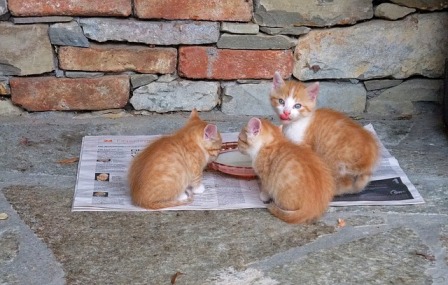Facts About Feeding Cats
Facts About Feeding Cats
A balanced diet is a basis for cat’s overall health. If the diet contains the proper nutrients and vitamins, a cat will be less prone to diseases and tend to live longer. However, feeding a cat healthy food requires learning at least the basic facts about the cat’s biological needs. Often, because not knowing much about the cat’s biological needs, some owners try to convert the cat into a vegetarian. Unfortunately, that could turn into a deadly mistake. Cats are a hundred percent carnivores. They need proteins and amino acids from meat. In the place of their ancestors, cats had been hunting preys for centuries. One of the most important nutrients that cats get from meat is taurine. Without it, cats can experience cardiovascular disease and even blindness; in the long term, lack of taurine can lead to premature death. To understand properly the essence of the feline diet, the article “Feline Nutrition: Basic Needs” introduce the basic facts about feeding cats.
Facts About Feeding Cats
• Protein: The primary source of food energy is protein. Typically, the cat’s diet should be derived from at least 25 to 30 protein, almost all of which
must be animal protein. The major sources of animal protein in commercial foods are meat, fish, eggs and dairy products.• Fats: The secondary source of food energy is fats. The cat requires a diet containing a lot of fat, 15 to 40 percent — far more than either the human or
the dog. Unlike proteins, fat does not provide a burden to the kidneys. Because of this, as a cat reaches old age, the fat content of its diet should be
increased somewhat while the protein content is decreased proportionately. In this manner, the proper overall energy content may be maintained while
easing the burden on the older kidneys. Remember though, an all fat diet is as bad as a no-fat diet!• Carbohydrates: Only about 5 percent of the total food energy should be carbohydrates. Simple carbohydrates, the sugars, are more easily assimilated into
the cat’s system, while the complex carbohydrates, the starches, pass through virtually untouched. Cooking complex carbohydrates such as potatoes, corn,
pastas, etc., starts the conversion from starch to sugar and aids in the digestion process.• Water: Fresh water should be available to your cat at all times. Cats with certain health problems, especially kidney failure and bladder infections need
to drink more water than the average cat. If you have trouble getting your cat to drink water, try adding a little water to their food. Vary the types of
bowls used. You cat may have a preference for a shorter bowl rather than a taller one.
Now that we are familiar with the building blocks of feeding cats, there is one more thing essential for cats’ good diet habits. Namely, more and more cats become obese because they simply eat too much. Obesity is a greater challenge for indoor cats because they are not as active as their ancestors in the wild were. They are, also, less motivated to explore their immediate environment unlike outdoor cats, who have been always exposed to enough stimuli. To help the cat in taking action and prevent it from obesity, we need to find a way to motivate it for play. There are various ideas around us ad we can easily make simple toys that will inspire the cat to run and jump. Cats also like new toys that are carefully designed to awaken cat’s enthusiasm for play. If a cat shows the signs of obesity, increasing in activities should be accompanied by smaller and lighter meals that are served only when the cat is hungry. As we have seen, it is pretty simple to feed the cat healthy food, but it needs our awareness on this. Every little effort we make for our lovely pets, will result in fewer visits to the vet and longer and happier life.










